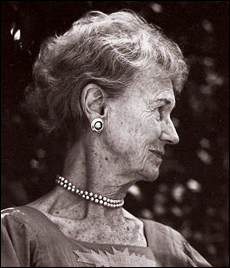Santa Fe Living Treasures – Elder Stories
<<Back to Treasures Index Emily
|
Emily Otis BarnesAs a little girl, the first time she saw New Mexico Emily Otis Barns said to herself: "This is where I shall live someday." Then, in 1927 she came west to visit her brother, the writer Raymond Otis. Through him, she met Mabel Dodge Luhan, Witter Bynner, and other writers and artists of the era. "I loved them," she said, and through meeting them, "doors flew open in all directions, and they became my friends, too." Born in 1906 in Evanston, Illinois, Emily lived her early life in Chicago. But starting at age nine, her father, a director of the Santa Fe Railroad, took her out of school to travel with him, in his private car on inspection trips to the Southwest, up through California, and into Canada. When the Depression came, her family's life changed. "Father lost a great deal, though not everything," she recalled. With little money, she and her new husband, architect Nathaniel Owings, who helped design the Chicago World's Fair, decided to go around the world. "We found a way to travel on freighters, on standby. We never knew what boat we were going to get on."The ten-month trip led them through the Orient, on second-class trains across India, from pension to pension, carrying their food. "It was an extraordinary journey," she remembered. In another of her adventures, Emily "went down Wolf Creek Pass without brakes--and lived." In 1944 she and her husband came to live in Santa Fe. They bought land and built a house in Pojoaque, where they raised their family of four children. "There were maybe nine thousand people here then. It was very beautiful and simple," she said. In the late 1960s Emily went to New York to seek what her children called "her late blooming fortune." With Margaret Mead and editor Normal Cousins, she promoted an "interesting but rather vast" scheme for global cultural exchanges, International Cooperation Year. The President's wife took an interest. Emily and two hundred others were invited to a White House conference. Lunch with Lady Bird Johnson was lovely, but "there were no results." The Wheelwright Museum, designed by Emily's friend William Penhallow Henderson, drew her into an enduring commitment. She calls the museum "my beloved place to be. In a way, it is my own temple." She was president of the board at the Wheelwright from 1983-85, executive secretary of the Southwest Association of Indian Affairs from 1971-76. |
